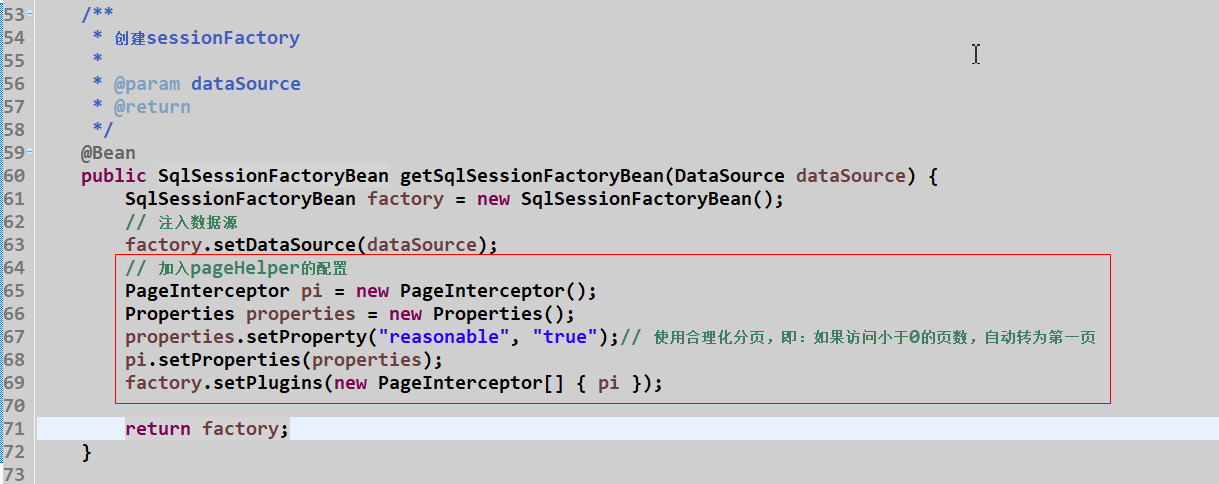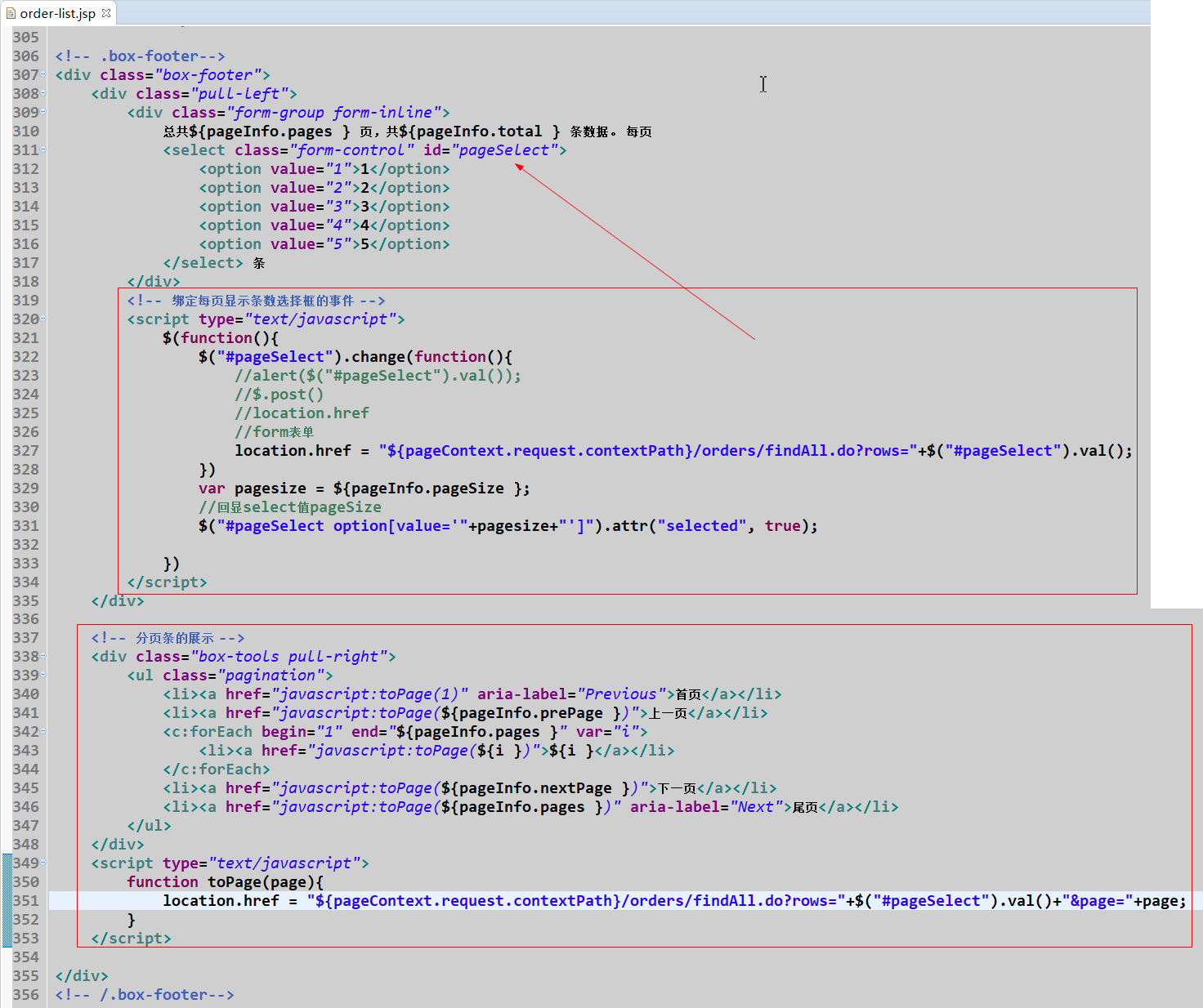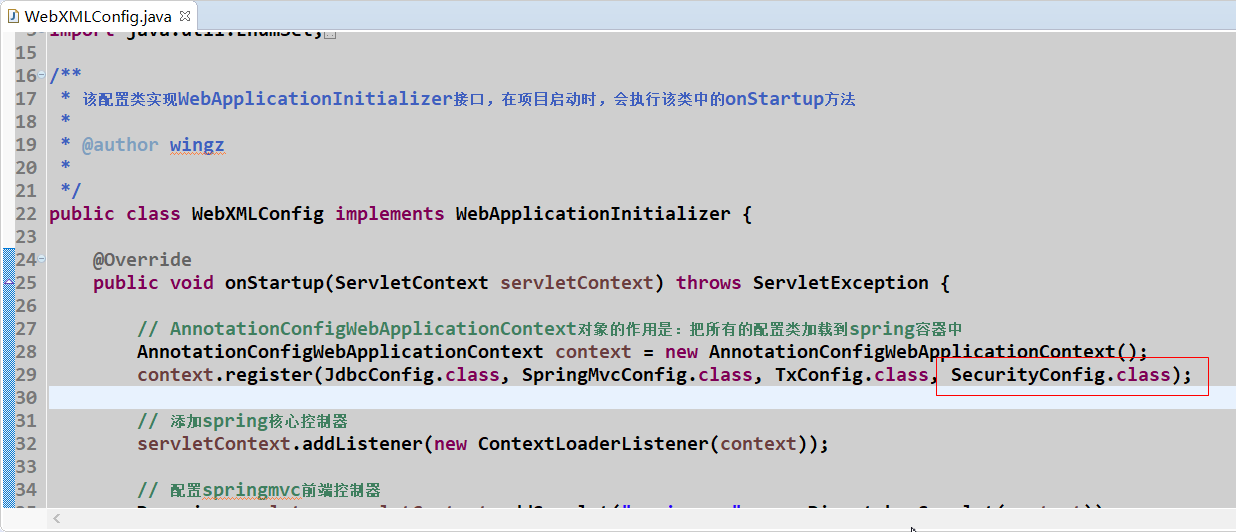一、自定义PageBean实体类实现分页操作
1、自定义PageBean实体类
package com.ssm.domain;
import java.util.List;
public class PageBean {
// 前台页面传递的数据
private Integer pageNum; // 当前页
private Integer rows; // 每页显示条数
// 后台查询出来的数据
private Integer totalCount; // 数据库中总记录条数
private List list; // 查询出来的指定页数中的数据集合
// 计算得出的属性
private Integer totalPage; // 总页数
private Integer prePage; // 上一页
private Integer nextPage; // 下一页
// Oracle数据库分页查询需要的参数
private Integer startPage; // 分页查询中rownum的起点
private Integer endPage; // 分页查询汇总rownum的终点
public PageBean(Integer pageNum, Integer rows, Integer totalCount) {
this.pageNum = pageNum;
this.rows = rows;
this.totalCount = totalCount;
/**
* 计算其余属性的值
*/
totalPage = (totalCount % rows == 0) ? (totalCount / rows) : (totalCount / rows + 1);
prePage = (pageNum - 1) == 0 ? 1 : pageNum - 1;
nextPage = pageNum == totalPage ? totalPage : pageNum + 1;
startPage = (pageNum - 1) * rows;
endPage = pageNum * rows > totalCount ? totalCount : pageNum * rows;
}
2、Dao查询PageBean
@Select("select count(1) from product")
public Integer findCount();
@Select("select * " +
" from (select rownum rn, p.* " +
" from (select * from PRODUCT) p " +
" where rownum <= #{endPage}) " +
" where rn >= #{startPage} ")
public List<Product> findByPage(@Param("startPage") Integer startPage, @Param("endPage") Integer endPage);
3、Service查询PageBean
/**
* 分页查询
*/
public PageBean findByPage(Integer pageNum, Integer rows) {
// 从数据库中查询表中总数量
Integer totalCount = productDao.findCount();
// 实例化PageBean,使用带参构造:当前页,每页显示条数,总记录数
PageBean pageBean = new PageBean(pageNum, rows, totalCount);
// 查询指定页的数据集合
List<Product> pageList = productDao.findByPage(pageBean.getStartPage(), pageBean.getEndPage());
pageBean.setList(pageList);
return pageBean;
}
二、使用PageHelper插件进行分页操作
1、加入PageHelper配置
PagerHelper是Mybatis提供的插件,需要注入在sqlSessionFactoryBean中,配置如下:
JdbcConfig.java
2、service、Controller中的方法
OrderServiceImpl.java
/**
* 分页查询的方法
*/
public List<Orders> findAllByPage(int page, int rows) {
//设置分页参数
PageHelper.startPage(page, rows);
//返回查询结果
return orderDao.findAll();
}
OrderController.java
@RequestMapping("findAll")
public String findAllByPage(Model model, @RequestParam(required = true, defaultValue = "1") int page,
@RequestParam(required = true, defaultValue = "5") int rows) {
// 查询集合
List<Orders> list = orderService.findAllByPage(page, rows);
// 将数据封装到pageHelper的pageBean对象中
PageInfo<Orders> pageInfo = new PageInfo<Orders>(list);
model.addAttribute("pageInfo", pageInfo);
return "order-list";
}
3、页面中分页条以及绑定事件
三、Spring Security
1、spring security小案例
(1)、spring配置文件
<?xml version="1.0" encoding="UTF-8"?>
<beans xmlns:xsi="http://www.w3.org/2001/XMLSchema-instance"
xmlns="http://www.springframework.org/schema/beans" xmlns:context="http://www.springframework.org/schema/context"
xmlns:tx="http://www.springframework.org/schema/tx" xmlns:aop="http://www.springframework.org/schema/aop"
xmlns:mvc="http://www.springframework.org/schema/mvc" xmlns:security="http://www.springframework.org/schema/security"
xsi:schemaLocation="http://www.springframework.org/schema/beans
http://www.springframework.org/schema/beans/spring-beans.xsd
http://www.springframework.org/schema/context
http://www.springframework.org/schema/context/spring-context.xsd
http://www.springframework.org/schema/tx
http://www.springframework.org/schema/tx/spring-tx.xsd
http://www.springframework.org/schema/aop
http://www.springframework.org/schema/aop/spring-aop.xsd
http://www.springframework.org/schema/security
http://www.springframework.org/schema/security/spring-security.xsd
http://www.springframework.org/schema/mvc
http://www.springframework.org/schema/mvc/spring-mvc.xsd ">
<!-- 放行登录页面,不拦截登录页面 -->
<security:http security="none" pattern="/login.jsp"></security:http>
<!-- auto-config="true" : 表示使用spring security默认登录页面 use-expressions="false"
: 表示不使用spEL表达式 -->
<security:http auto-config="true" use-expressions="false">
<!--
pattern="/**" : 表示拦截所有路径下的请求
access="ROLE_USER" : 表示访问url时需要的权限
如果没有对应的权限,会自动跳转到spring security提供的登录页面,
如果有自己的登录页面,需要配置 -->
<security:intercept-url pattern="/**" access="ROLE_USER" />
<!-- 配置自己的登录页面
login-page : 页面位置
login-processing-url : 访问的url
username-parameter : 用户名
password-parameter : 密码
default-target-url : 登录成功要跳转的页面
authentication-failure-url : 登录失败要跳转的页面
-->
<security:form-login login-page="/login.jsp"
login-processing-url="/login" username-parameter="username"
password-parameter="password" default-target-url="/success.jsp"
authentication-failure-url="/fail.jsp"/>
<!-- 关闭csrf验证 -->
<security:csrf disabled="true"/>
</security:http>
<!-- 在内存中临时放置两个用户 -->
<security:authentication-manager>
<security:authentication-provider>
<security:user-service>
<!-- {noop} : 表示不加密登录 -->
<security:user name="user" password="{noop}user"
authorities="ROLE_USER" />
<security:user name="admin" password="{noop}admin"
authorities="ROLE_ADMIN" />
</security:user-service>
</security:authentication-provider>
</security:authentication-manager>
</beans>
(2)、web.xml配置文件
<?xml version="1.0" encoding="UTF-8"?> <web-app xmlns:xsi="http://www.w3.org/2001/XMLSchema-instance" xmlns="http://xmlns.jcp.org/xml/ns/javaee" xsi:schemaLocation="http://xmlns.jcp.org/xml/ns/javaee http://xmlns.jcp.org/xml/ns/javaee/web-app_3_1.xsd" version="3.1"> <display-name>security_demo</display-name> <welcome-file-list> <welcome-file>index.html</welcome-file> <welcome-file>index.htm</welcome-file> <welcome-file>index.jsp</welcome-file> <welcome-file>default.html</welcome-file> <welcome-file>default.htm</welcome-file> <welcome-file>default.jsp</welcome-file> </welcome-file-list> <!-- 初始化spring容器 --> <listener> <listener-class>org.springframework.web.context.ContextLoaderListener</listener-class> </listener> <context-param> <param-name>contextConfigLocation</param-name> <param-value>classpath:applicationContext-security.xml</param-value> </context-param> <!-- 配置security过滤器 DelegatingFilterProxy:该过滤器是用来注册第三方过滤器的过滤器代理对象, 名字不能随便写,只能是springSecurityFilterChain 使用spring security需要注册提供的11个过滤器,组成一个过滤器链,这个链的名字就是:springSecurityFilterChain --> <filter> <filter-name>springSecurityFilterChain</filter-name> <filter-class>org.springframework.web.filter.DelegatingFilterProxy</filter-class> </filter> <filter-mapping> <filter-name>springSecurityFilterChain</filter-name> <url-pattern>/*</url-pattern> </filter-mapping> </web-app>
四、将spring security使用零配置加入项目中
1、创建数据库表
CREATE TABLE sys_user( id varchar2(32) default sys_guid() primary key, username VARCHAR2(50) UNIQUE NOT NULL, email VARCHAR2(50) , PASSWORD VARCHAR2(80), phoneNum VARCHAR2(20), STATUS number );
2、创建实体类
public class SysUser {
private String id;
private String username;
private String email;
private String password;
private String phoneNum;
private Integer status;
3、创建Dao、service
SysUserDao.java
package com.ssm.dao;
import org.apache.ibatis.annotations.Select;
import com.ssm.domain.SysUser;
public interface SysUserDao {
@Select("select * from sys_user where username = #{username}")
public SysUser findUserByName(String username);
}
SysUserService.java接口
package com.ssm.service;
import org.springframework.security.core.userdetails.UserDetailsService;
/**
* 接口必须继承spring security需要的Service类型
* @author wingz
*
*/
public interface SysUserService extends UserDetailsService {
}
SysUserServiceImpl.java
package com.ssm.service.impl;
import java.util.ArrayList;
import java.util.List;
import org.springframework.beans.factory.annotation.Autowired;
import org.springframework.security.core.authority.SimpleGrantedAuthority;
import org.springframework.security.core.userdetails.User;
import org.springframework.security.core.userdetails.UserDetails;
import org.springframework.security.core.userdetails.UsernameNotFoundException;
import org.springframework.stereotype.Service;
import org.springframework.transaction.annotation.Transactional;
import com.ssm.dao.SysUserDao;
import com.ssm.domain.SysUser;
import com.ssm.service.SysUserService;
@Service
@Transactional
public class SysUserServiceImpl implements SysUserService {
@Autowired
private SysUserDao userDao;
/**
* spring security进行用户登录的方法
* 如果查询到用户,返回spring security自定义的user对象
* 如果没有查询到用户,返回null,spring security就会知道登录失败
*/
public UserDetails loadUserByUsername(String username) throws UsernameNotFoundException {
SysUser sysUser = userDao.findUserByName(username);
if (sysUser != null) {
List<SimpleGrantedAuthority> list = new ArrayList<>();
list.add(new SimpleGrantedAuthority("ROLE_USER"));
User user = new User(sysUser.getUsername(), "{noop}" + sysUser.getPassword(), list);
return user;
}
return null;
}
}
4、创建spring security的配置类
SecurityConfig.java : 用来进行spring security的配置,相当于配置文件application-security.xml
package com.ssm.config;
import org.springframework.beans.factory.annotation.Autowired;
import org.springframework.context.annotation.Configuration;
import org.springframework.security.config.annotation.authentication.builders.AuthenticationManagerBuilder;
import org.springframework.security.config.annotation.web.builders.HttpSecurity;
import org.springframework.security.config.annotation.web.configuration.EnableWebSecurity;
import org.springframework.security.config.annotation.web.configuration.WebSecurityConfigurerAdapter;
import com.ssm.service.SysUserService;
/**
* spring security的配置类 该类用来创建过滤器链对象
*
* @author wingz
*
*/
@Configuration
@EnableWebSecurity // 注册过滤器链
public class SecurityConfig extends WebSecurityConfigurerAdapter {
@Autowired
private SysUserService userService;
/**
* 认证方法
*/
public void configure(AuthenticationManagerBuilder auth) throws Exception {
super.configure(auth);//不能删除
//让spring security使用自定义的service层方法
auth.userDetailsService(userService);
}
@Override
public void configure(HttpSecurity http) throws Exception {
http.authorizeRequests()
//放行的操作
.antMatchers("/index.jsp", "/login.jsp", "/login.do", "/pages/aside.jsp", "/pages/header.jsp",
"/css/**", "/img/**", "/plugins/**")
//配置其他页面以及权限
.permitAll().anyRequest().authenticated().and().csrf().disable().formLogin().loginPage("/login.jsp")
.loginProcessingUrl("/login.do").successForwardUrl("/pages/main.jsp").failureForwardUrl("/failer.jsp")
.permitAll();
}
}
SecurityWebInit.java : 用来进行注册过滤器链,相当于web.xml中配置过滤器以及加载配置文件
package com.ssm.config;
import org.springframework.security.web.context.AbstractSecurityWebApplicationInitializer;
/**
* 该类作用是将过滤器链对象添加到web容器中
*
* @author wingz
*
*/
public class SecurityWebInit extends AbstractSecurityWebApplicationInitializer {
}
5、将spring security的配置注册到web.xml中
五、基于security的用户登录的认证和授权
1、用户退出的方法
用户登录和退出的方法都在spring security的配置文件中配置,配置如下:
SecurityConfig.java
2、添加其他表结构以及实体类(角色、权限)
---系统角色表 CREATE TABLE sys_role( id varchar2(32) default sys_guid() primary key, roleName VARCHAR2(50), roleDesc VARCHAR2(50) ); ---系统用户角色对应关系表 CREATE TABLE user_role( userId varchar2(32), roleId varchar2(32), PRIMARY KEY (userId,roleId), FOREIGN KEY (userId) REFERENCES sys_user(id), FOREIGN KEY (roleId) REFERENCES sys_role(id) ); ---系统权限表 CREATE TABLE sys_permission( id varchar2(32) default sys_guid() primary key, permissionName VARCHAR2(50) , url VARCHAR2(50) ); ---系统角色权限对应关系表 CREATE TABLE role_permission( permissionId varchar2(32), roleId varchar2(32), PRIMARY KEY (permissionId,roleId), FOREIGN KEY (permissionId) REFERENCES sys_permission(id), FOREIGN KEY (roleId) REFERENCES sys_role(id) );
public class SysRole {
private String id;
private String roleName;
private String roleDesc;
private List<SysPermission> permissions;
private List<SysUser> users;
public class SysPermission {
private Integer id;
private String permissionName;
private String url;
private Integer pid;
private List<SysRole> roles;
3、用户的添加和列表的展示
4、



